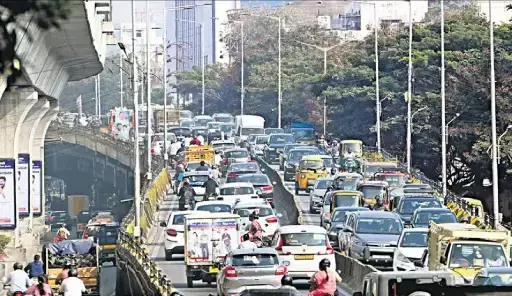Live
- Tabling CAG reports: BJP legislators move Delhi HC for special Assembly sitting
- Allu Arjun Faces Legal Case; Minister Seethakka Criticizes Lack of Support for Victim’s Family
- Taiwan Excellence announces the Top 3 global winners for Go Green with Taiwan
- Delhi High Court Denies Bail to IAS Trainee Puja Khedkar Over Forgery and Fraud Charges
- BJP rejects Kharge’s charge on EC’s ‘erosion’, says ‘most changes brought during Cong rule’
- 59 pc people seek GenAI smartphones by 2025 end globally: Report
- Crime Rate in Rachakonda Increases by 4% in 2024, Cybercrimes Surge by 42.5%
- AIM, Niti Aayog’s Youth Co:Lab challenge 2025 to foster innovation for disabled
- IIT Delhi students receive job offers from US, UK, UAE, Japan in abundance
- Pushpa 2 Leads to the Capture of Notorious Gangster Vishal Meshram in Nagpur
Just In
Hyderabad Population 2024: 1.6 Crore People and 85 Lakh Vehicles Under HYDRAA's Jurisdiction


Hyderabad Population 2024: 1.6 Crore People and 85 Lakh Vehicles Under HYDRAA's Jurisdiction
Hyderabad's population reaches 1.6 crore with 85 lakh vehicles under HYDRAA's jurisdiction, highlighting the need for effective disaster management and traffic control.
Hyderabad Disaster Response and Asset Protection Agency (HYDRAA) is an essential initiative aimed at safeguarding the city's growing infrastructure amid its rapid urbanization. According to A.V. Ranganath, the commissioner of HYDRAA, the agency plays a crucial role in managing urban flooding, traffic congestion, and disaster response in the city. His remarks came during a workshop held in Hyderabad on November 22, 2024, to commemorate the 150th anniversary of the India Meteorological Department (IMD).
HYDRAA's Mandate: Protecting Public Spaces and Urban Infrastructure
Established just a few months ago, HYDRAA is tasked with protecting vital public assets such as parks, roads, water bodies, and open spaces. "Urban flooding and disaster management are becoming increasingly critical issues in our rapidly urbanizing state," said Ranganath. He likened the creation of HYDRAA to the formation of the Indian Meteorological Department in 1875, following a deadly cyclone in Bengal, noting that both agencies were established to address natural disasters and safeguard lives.
HYDRAA's jurisdiction spans 2,000 square kilometers, covering a massive area with a population of 1.6 crore people (Hyderabad population 2024). This sprawling urban area is home to approximately 85 lakh vehicles in Hyderabad, contributing to significant traffic challenges, particularly during adverse weather conditions. The growing demand for transportation and the increasing Hyderabad vehicle count 2024 further underscore the need for effective traffic management and disaster response.
Rising Urbanization and Its Impact on Disaster Management
According to Ranganath, urbanization in India is accelerating rapidly, with approximately 33-34% of the country’s population now living in urban areas. This figure is expected to increase to 50% in the coming decades. "This shift in demographics presents new challenges for disaster management, especially in megacities like Hyderabad," he added. With 85 lakh vehicles in Hyderabad and an expanding population, the city is particularly vulnerable to the impacts of urban flooding, which can cause major traffic disruptions.
A simple rainfall event, as little as 2 cm, can cause severe traffic delays and create widespread chaos. "Lakes and nalas have vanished, and even a brief spell of rain can cause traffic to come to a standstill," Ranganath said, emphasizing the need for targeted disaster management strategies.
The Need for Precise Early Warnings
One of the most pressing challenges in disaster management is the timely issuance of early warnings. "A general warning for rainfall is often insufficient to allow citizens and agencies to respond adequately," Ranganath noted. With HYDRAA's jurisdiction vehicles accounting for a significant portion of the city's traffic, precise weather forecasts are essential for effective disaster preparedness. He added, "A three-hour warning window is often too short, and we need more specific and actionable alerts to ensure the public and authorities have enough time to respond."
Ranganath stressed that specific, location-based weather alerts are critical to ensuring the public takes warnings seriously and acts accordingly to avoid traffic disruptions and flooding. "General alerts will not do. Only precise and actionable weather data will help mitigate the impacts of urban flooding."
HYDRAA's Role in Managing Traffic and Urban Disasters
With a population of 1.6 crore people in Hyderabad and an expanding fleet of vehicles, the pressure on the city's transportation infrastructure is immense. HYDRAA Hyderabad traffic data plays a crucial role in managing disaster response, particularly during weather-related disruptions. As Hyderabad vehicle statistics continue to rise, the need for efficient disaster management systems that integrate traffic data with weather forecasts becomes increasingly critical.
Ranganath pointed out that HYDRAA has also had a positive impact on enforcing stricter regulations on urban encroachments and ensuring that public spaces are protected from unauthorized construction. This has helped create a safer environment for residents and improved the overall management of public infrastructure.
IMD’s Contribution to Disaster Preparedness
During the workshop, K. Nagaratna, head of the Meteorological Centre Hyderabad, highlighted how the state’s weather stations are playing a crucial role in forecasting and providing real-time data to agencies like HYDRAA. With a network of observatories and sensors in place, Telangana is well-equipped to meet the state’s growing weather forecasting needs.
Conclusion: Building a Resilient Hyderabad
As Hyderabad continues to grow both in terms of population and vehicle count, the challenges posed by urbanization require a coordinated approach to disaster management. HYDRAA plays a vital role in protecting urban assets, managing traffic disruptions, and ensuring that the city’s infrastructure is resilient to the impacts of climate change and extreme weather events. With an increasing focus on precise early warnings and integrated weather data, HYDRAA is set to become a cornerstone in making Hyderabad safer and more sustainable for its citizens.
For continuous updates on Hyderabad's transportation statistics, disaster management initiatives, and weather alerts, stay tuned to our coverage on HYDRAA's role in safeguarding Hyderabad’s public spaces and IMD’s forecasts for the region.

© 2024 Hyderabad Media House Limited/The Hans India. All rights reserved. Powered by hocalwire.com






